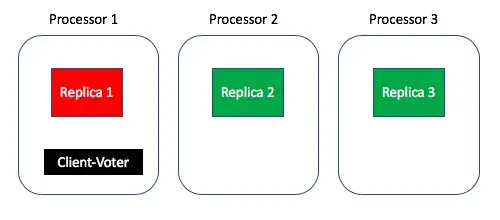I need help understanding the following text from section 4.2 on this paper: Implementing Fault-Tolerant Services Using the State Machine Approach: A Tutorial
Dependent-Failures Output Optimization. If a client and a state machine replica run on the same processor, then even when Byzantine failures are possible, the client need not gather a majority of responses to its requests to the state machine. It can use the single response produced locally.
If understand correctly, you have 2t + 1 replicas with one of the replicas with a voter client. In the simplest case you have t=0 and therefore 1 replica with the client voter on the same processor. This means that regardless the correctness of the replica, the output is the client's absolute truth. The case that confuses me is when a t=1 and you have 3 replicas. Let us say that the local replica to the client with a voter is faulty then we get something like this:

If the client's local replica is faulty and it doesn't gather a majority of responses, then the voter will vote on a wrong output. What am I missing?